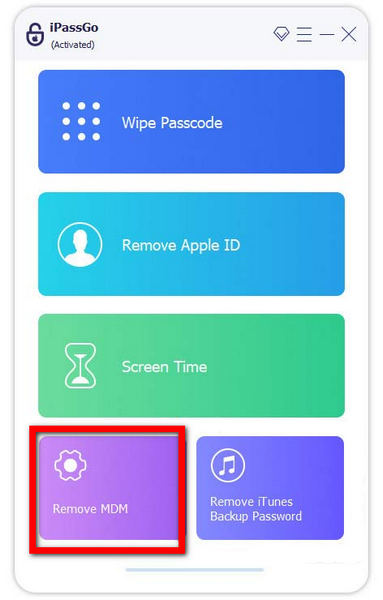Full Review - Understanding Mobile Device Management Essentials
As you start a new job, your employer asks you to install Mobile Device Management or MDM software on your smartphone. Do you know what MDM is and how it impacts your device? Explore this article to understand MDM's role, features, and considerations for employers and employees.

In this article:
Part 1. What is Mobile Device Management (MDM)

Mobile Device Management (MDM) is a type of security software that allows IT managers to protect data by remotely enforcing policies on laptops, smartphones, tablets, and other mobile devices within an enterprise. It serves as the basis for Enterprise Mobility Management, or EMM, a collection of services and technologies that protect business data on employee devices, including mobile application management and mobile content management. MDM extends the security of the organization's corporate network to company-owned and employee-owned devices, ensuring data protection and compliance with organizational policies.
Part 2. Main Functions of Mobile Device Management
The seven essential features of Mobile Device Management solutions are:
1. All-encompassing device and operating system support: MDM solutions should support a wide range of gadget types as well as operating systems, such as iOS and Android, to accommodate various mobile technologies and BYOD policies.
2. Device security capabilities: MDM solutions must provide robust security measures to protect corporate data, including features like data encryption, security configuration, access monitoring, and resistance against unauthorized iPhone unlock software.
3. Access control features: To ensure that only authorized users access business data, MDM solutions should offer authentication and identity measures for secure access control.
4. Over-the-air or OTA distribution: MDM solutions should support OTA distribution to wirelessly deliver configuration, provision, or management updates to devices without relying on physical connections.
5. Device troubleshooting: Remote troubleshooting capabilities allow IT teams to identify and resolve device issues remotely from the management console, saving time and resources.
6. Remote wiping: In case of security breaches or lost devices, MDM solutions should enable remote wiping of corporate data from devices To prevent unauthorized access, as well as the ability to lock iPhones remotely to secure sensitive information further.
7. Device location tracking: MDM solutions should offer GPS tracking functionality to track device locations, aiding in device recovery and ensuring the security of sensitive corporate data.
Part 3. Cons of Mobile Device Management
While Mobile Device Management/MDM offers significant benefits for organizations, there are also some drawbacks to consider:
Limited Control Over Personal Devices:
Employees may resist MDM policies on personal devices in BYOD setups, causing tension over privacy and usage and challenging IT control.
User Experience Impact:
MDM's strict security policies may hinder user experience, causing frustration. For instance, complex passwords and app restrictions may impede productivity and satisfaction.
Device Compatibility Issues:
MDM may need more support for all device types and OSes, posing compatibility challenges. With rapid mobile tech evolution, managing diverse device fleets becomes difficult due to potential compatibility issues.
Complexity and Overhead:
Deploying and managing MDM solutions is complex and resource-intensive, demanding specialized knowledge and ongoing maintenance. IT departments invest significant time and resources in effectively training and managing MDM systems.
Risk of Security Breaches:
Despite enhancing security, MDM solutions may introduce vulnerabilities if not configured or appropriately maintained. Malicious actors could exploit remote access and tracking features.
Cost Considerations:
Implementing MDM incurs upfront costs for licensing, implementation, ongoing support, and expenses for training, integration, and compliance.
Dependency on Internet Connectivity:
MDM relies on internet connectivity for remote management. Connectivity or network outages can help effective device management.
Part 4. How to Use MDM
To use Mobile Device Management, follow these steps:
Select an MDM solution that meets your organization's needs, considering device compatibility, security features, and scalability factors.

Install the MDM software on your organization's servers or use a cloud-based MDM platform provided by the vendor.
Onboard devices by enrolling them with the MDM solution. This typically involves installing an MDM agent or profile on each device.
Establish security policies, configuration settings, and access controls within the MDM console. Customize policies based on organizational requirements and compliance standards.
Utilize the MDM console to manage enrolled devices centrally. This includes tasks such as applying policies, pushing updates, monitoring device health, and troubleshooting issues remotely.
Implement security procedures to secure corporate data on managed devices, such as encryption, remote wipe capabilities, and malware detection.
Monitor device compliance with established policies and security standards daily. Receive alerts or notifications for non-compliant devices and take corrective actions as needed.
Part 5. How to Remove MDM from iPhone and Android
iPhone:
Are you stuck with MDM restrictions on your iPhone? Don't let them hold you back. With imyPass iPassGo, you can easily remove MDM apps and regain control. Learn its key features and steps to get the job done, whether for work or personal use.

4,000,000+ Downloads
Efficiently removes Mobile Device Management or MDM.
Free your devices from restrictions.
Additional features include Removing Apple ID, Bypassing Screen Time, and more.
Safe and easy to use.
Here are the steps for removing MDM from iPhone:
Download and install imyPass iPassGo on your computer. Then, launch the program and select the Remove MDM mode. Follow the prompts to start deleting MDM from your iPhone.

Afterward, connect your device to the computer using a USB cord. Within the program, select the Start button to begin the process of deleting Mobile Device Management from your device.

Finally, the MDM app has been removed from your iPhone. To finish the transaction, click the OK button.

Android:
Here's a straightforward guide to removing Mobile Device Management from Android devices: Access your device settings to disable the MDM agent efficiently. Follow the instructions below to complete the process.
Open Settings on the managed mobile device.
Then, navigate to Security.

Next, select Device Administrator and turn it off.
Under Settings, go to Applications.
Finally, find Manage Engine Mobile Device Manager Plus and uninstall the MDM agent.
FAQs.
-
What can my company see with mobile device management?
With Mobile Device Management or MDM, your company can monitor and manage various aspects of enrolled devices, such as device location, app usage, network connectivity, and compliance with security policies. Additionally, MDM allows for remote troubleshooting, application deployment, and data encryption. However, the visibility depends on your company's specific policies and configurations, balancing security needs with employee privacy concerns.
-
Should I turn off device management?
Turning off device management depends on your organization's security and management needs. Disabling device management may provide users more autonomy but could compromise security and compliance. Evaluate the risks and benefits carefully, considering factors like data protection, regulatory requirements, and the potential impact on device security and management capabilities before deciding. Regularly review and update device management settings as needed to align with organizational goals.
-
Should I allow MDM on my phone?
Allowing Mobile Device Management on your phone depends on your comfort with the organization's policies. While it enhances security, it grants control over your device. Discuss concerns with IT and review guidelines. If removing MDM from the iPhone, understand the process and consequences.
-
Is it possible to bypass or remove Mobile Device Management from a device?
While bypassing or removing Mobile Device Management from a device is technically possible, it may violate organizational policies and compromise device security. Attempting to circumvent MDM controls could also result in losing access to corporate resources or disciplinary action. It's essential to adhere to company policies and consult with IT administrators for proper procedures regarding MDM management.
-
What security measures does MDM provide?
Mobile Device Management employs various security features like device encryption, remote data wipe, and access control to help protect corporate data from illegal access. By enforcing security policies, monitoring device activity, and remotely managing devices, MDM helps mitigate the risk of data breaches and unauthorized use of sensitive information.
Conclusion
Tackling Mobile Device Management is crucial for organizations and individuals navigating the complexities of data security and device management complexities. Understanding MDM's functions, benefits, and potential drawbacks enables people to make educated decisions regarding their device usage. By prioritizing data protection and privacy while leveraging mobile device management capabilities, businesses and employees can confidently navigate the digital landscape.
Hot Solutions
-
Unlock iOS
- Review of the Free iCloud Unlock Services
- Bypass iCloud Activation With IMEI
- Remove Mosyle MDM from iPhone & iPad
- Remove support.apple.com/iphone/passcode
- Review of Checkra1n iCloud Bypass
- Bypass iPhone Lock Screen Passcode
- How to Jailbreak iPhone
- Unlock iPhone Without Computer
- Bypass iPhone Locked to Owner
- Factory Reset iPhone Without Apple ID Password
-
iOS Tips
-
Unlock Android
-
Windows Password

